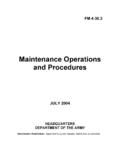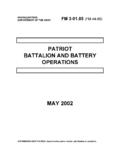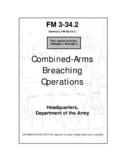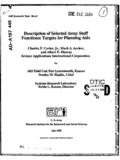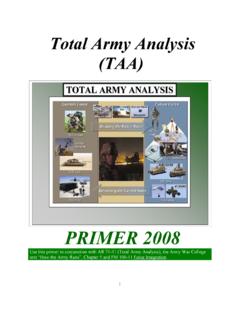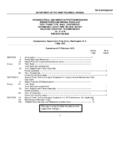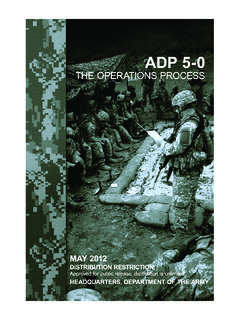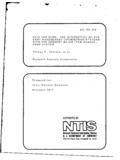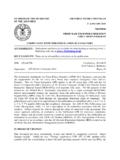Transcription of AIR DEFENSE ARTILLERY REFERENCE HANDBOOK - BITS
1 HEADQUARTERS FM (FM 44-100-2). DEPARTMENT OF THE army . AIR DEFENSE ARTILLERY . REFERENCE HANDBOOK . DISTRIBUTION RESTRICTION: Approved for public release; distribution is unlimited.. FM (FM 44-1-2). Field Manual Headquarters No. Department of the army Washington, DC, 31 OCTOBER 2000. Air DEFENSE ARTILLERY REFERENCE HANDBOOK Contents Page Preface .. iii Chapter 1 AIR DEFENSE ARTILLERY MISSION ..1-1. Mission ..1-1. Air and Missile DEFENSE in Relation to army Tenets ..1-2. Air and Missile DEFENSE in Force Air DEFENSE Battlefield Operating System ..1-3. Chapter 2 The Evolving Electronic Warfare ..2-8. Weapons of Mass Chapter 3 SHORT RANGE AIR DEFENSE ..3-1. MANPADS Bradley Stinger Fighting Linebacker System ..3-11. Avenger Chapter 4 THEATER HIGH ALTITUDE AREA DEFENSE Mission.
2 4-1. System Description ..4-1. Distribution Restriction: Approved for public release; distribution is unlimited.. This publication supersedes FM 44-1-2, 15 June 1984. i FM 44-100-2. System Operational 4-10. Chapter 5 PATRIOT AIR DEFENSE SYSTEM .. 5-1. Mission .. 5-1. System Description Battalion Fire Direction Center .. 5-1. System Description - Firing 5-3. System Operational 5-9. Patriot Logistics Support .. 5-16. Chapter 6 COMMAND AND CONTROL SYSTEMS .. 6-1. Air and Missile DEFENSE Battle Command Organizations .. 6-1. Air and Missile DEFENSE Planning and Control 6-2. Tactical Command System .. 6-6. Master Information and Coordination Central .. 6-6. Forward Area Air DEFENSE C3I System .. 6-6. Chapter 7 TRAINING DEVICES AND AERIAL 7-1. MANPADS Stinger Training Devices.
3 7-1. Bradley Stinger Fighting Vehicle/Linebacker Training Devices .. 7-4. Avenger Training Devices .. 7-6. Sentinel Training 7-7. FAAD C3I Training Devices .. 7-7. Patriot Training Devices .. 7-8. THAAD Training Devices .. 7-11. Joint Radio Operator and Maintenance Procedures 7-13. Aerial Targets for 7-14. Appendix A ADA EMPLOYMENT PRINCIPLES, GUIDELINES, AND PRIORITIES ..A-1. Appendix B ADA SYMBOLS ..B-1. GLOSSARY ..Glossary-1. BIBLIOGRAPHY .. Bibliography-1. INDEX .. Index-1. ii Preface The purpose of this field manual (FM) is to familiarize personnel with ADA operations and weapon systems. This FM will be useful to personnel serving in the following types of positions: staff positions requiring general knowledge of Air DEFENSE ARTILLERY systems and operations instructor positions in service schools and the Reserve Officer Training Corps (ROTC).
4 Members of advisory elements and groups assigned to missions in foreign countries advisory positions in reserve component forces command and leadership positions in special operations force units executive positions and advisory positions that require knowledge of air DEFENSE subjects Readers are reminded that weapons systems and operations are continually changing. Publications such as technical manuals, tables of organization and equipment, and mission training plans (MTP) provide more detailed information on specific subjects. Many of these sources are referred to in appropriate sections of this field manual. The proponent for this manual is HQ TRADOC. Send comments and recommendations on DA Form 2028 to Commandant, USAADASCH, ATTN: ATSA-DT-WF, Fort Bliss, TX 79916-3802.
5 Unless this publication states otherwise, masculine nouns and pronouns do not refer exclusively to men. iiiIII. Chapter 1. Air DEFENSE ARTILLERY Mission This chapter addresses the Air DEFENSE ARTILLERY (ADA) mission and the relationship to the army tenets and battlefield operating systems. ADA. contributes unique capabilities to theater counterair and theater missile DEFENSE operations as part of a joint, multinational, or interagency team. The theater objectives of ADA are to preserve combat power, gain the initiative, and support offensive operations. MISSION. 1-1. The mission of US army Air DEFENSE ARTILLERY is to protect the force and selected geopolitical assets from aerial attack, missile attack and surveillance. FORCES. 1-2. ADA commanders allocate active and reserve component ADA assets based on the supported commander's priorities.
6 In addition, the mission is broadly written to include protection of critical assets, installations, and facilities along with joint and multinational forces when required. GEOPOLITICAL ASSETS. 1-3. Geopolitical assets are nonmilitary assets that US, allied, or host nation civil authorities nominate for air and missile DEFENSE protection. These assets could be political, religious, ethnic, historical, or territorial in nature. Since protection of geopolitical assets may not directly support military operations, integration of geopolitical assets into the air and missile DEFENSE priorities list must be done at the highest levels. Geopolitical assets may include US. territories. THREAT. 1-4. The threat includes all aircraft, aerial surveillance platforms, and theater missiles.
7 Chapter 2 provides more detail and information on the threat. CONSEQUENCES. 1-5. Successful air and missile DEFENSE is key to generating and sustaining combat power in force projection operations. The AD contribution to friendly efforts to counter threat reconnaissance, intelligence surveillance, and target acquisition efforts has gained greater emphasis. Current and future army ADA capabilities, both active and reserve component, must synergistically combine with the AD assets of other services to defeat the multifaceted threat. army ADA forces participate in operations at all levels of war. 1-1. FM 44-100-2. AIR AND MISSILE DEFENSE IN RELATION TO army TENETS. 1-6. Air and missile DEFENSE operations are inherently joint operations, multi- component, and embody army doctrine.
8 ADA forces are versatile, agile, and fight throughout the depth of the battlefield. Through aggressive planning and fully orchestrated execution, ADA allows the commander at any level to seize and maintain the initiative. Commanders integrate air and missile DEFENSE operations into campaigns fought at the operational level, and battles and engagements fought at the tactical level. INITIATIVE. 1-7. Air DEFENSE ARTILLERY units participate in planning for offensive and defensive counterair and theater missile DEFENSE operations. Air and missile DEFENSE commanders recommend enemy airfields, missile launch sites, command and control nodes, and logistics for deep attack. They contribute to winning the information war by destroying threat aerial reconnaissance platforms.
9 ADA units engage air threats from directions and in ways that the enemy does not expect. AGILITY. 1-8. ADA units anticipate and counter enemy actions and react rapidly to changes in the situation. Agility is as much a mental quality as a physical one. ADA must quickly change from offense to DEFENSE , entry to decisive operations, and counterair to theater missile DEFENSE . Concentrating coverage and fires, or screening the flanks from attack and surveillance, are tasks routinely accomplished by ADA units. DEPTH. 1-9. ADA units are among the first units to deploy during force-projection operations and the last units to depart during redeployment operations. They conduct operations throughout the width and depth of the theater. ADA units achieve DEFENSE in depth using a system of systems approach, which gives multiple opportunities to defeat the aerial threat.
10 ADA systems see deep into threat airspace to contribute to the commander's situational awareness and defeat air, missile, and surveillance threats at maximum range. Depth also includes staying power, which is the access to adequate resources to continue the fight. army air and missile DEFENSE includes contributions from all battlefield operating systems and units. SYNCHRONIZATION. 1-10. The Synchronization tenet requires controlling the tempo of operations as well as weighting and shifting air and missile DEFENSE efforts. ADA units counter the entire aerial threat spectrum by integrating a system of systems. Commanders integrate their operations horizontally with all battlefield operating systems and vertically with both higher and lower ADA units. VERSATILITY.




